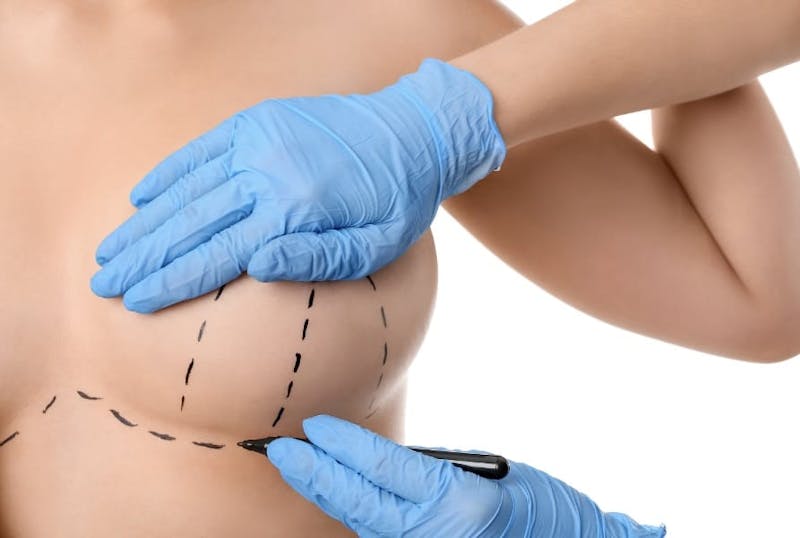
Breast lift surgery can be a very rewarding surgical procedure for women who have deflated, sagging breasts due to aging, significant weight loss, or pregnancy.
Some potential breast lift patients are concerned about the amount of scarring associated with breast lift surgery, which is determined by the amount of correction needed and which breast lift techniques are preformed.
The more excess breast skin that needs to be removed, the more or longer incisions necessary. Here is a synopsis of the common breast lift incision options and how to determine which breast lift procedure might be the best for you.
MINIMAL SAGGING: CRESCENT LIFT INCISION
If you have a very limited amount of sagging to correct, the “crescent lift” may be the best option. The small incision runs around the edge of the areola, along the top half only. This incision is not as common and is usually used when the patient is also having a breast augmentation.
Patients with low nipples are ideal candidates for this type of incision. A crescent breast lift is effective in enhancing the positioning of the nipple and areola.
If the nipple or areola appears to point downward or sits lower on the chest wall than desired, a crescent breast lift is considered an appropriate technique for addressing these concerns.
Generally a crescent lift is for those who have only slight breast sagging with only about a 2 cm lift of the nipple able to be achieved.
MILD SAGGING: PERI-AREOLAR LIFT INCISION
This breast lift incision is also often performed with a breast augmentation, but it is an effective breast lift technique for those with mild breast sagging looking to improve breast contour.
Also called the “donut lift,” the peri-areolar breast lift involves a scar that encircles the entire areola along the line of pigmentation change. The scar in the breast tissue fades with time and is usually difficult to detect.
This type of incision is commonly used for procedures such as breast augmentation, breast lift, or the removal and exchange of breast implants. This surgical cut is made just below the lower half of the areola, the pigmented circle around the nipple.
Periareolar plastic surgery is well-suited for individuals with small to moderately-sized chests, especially those with good skin elasticity.
Larger-breast size individuals typically require a double incision approach for their plastic surgery. People with moderately-sized chests but less skin elasticity may also find that a double incision is a more suitable option.
MODERATE SAGGING: VERTICAL LIFT INCISION
For more moderate sagging that may involve sagging nipples or nipples that fall below the breast crease, a vertical incision is added. The breast is reshaped and the skin is repositioned first with the peri-areolar incision and, second, with a vertical incision from the bottom of the areola to the inframammary fold.
This creates the shape of a “lollipop,” which is another nickname for the technique.
To execute a vertical breast lift, the breast lift procedure begins under general anesthesia. Two incisions are made: the first breast lift incision follows the outline of the areola, forming a ‘half-moon’ shape, and the second is a downward vertical incision that extends to the breast crease.
SIGNIFICANT SAGGING: INVERTED-T LIFT INCISION
Women who have significant breast sagging and need extensive reshaping can benefit from the inverted-T incision, also called an “anchor lift.”
Three incisions are used: the peri-areolar incision, the vertical incision mentioned above, and a final incision beneath the breast tissue that follows the natural breast crease.
Opting for the Inverted T method eliminates the need to place the nipple and areola as a free nipple graft, as required in Double Incision techniques.
Consequently, the Inverted T method may offer a potentially better chance of preserving pre plastic surgery levels of sensation in the nipples, although this outcome is not guaranteed.
While the vertical scar in a breast lift procedure is the most noticeable of all incisions, it will significantly fade over time. Most patients are completely satisfied with their breast lift results and the restored youthfulness of their newly shaped breasts.
Questions and Answers
Which breast lift has the least scarring?
Referred to as Sub-Areola Mastopexy or scarless breast lift, this technique minimizes visible scarring for patients. An incision is strategically made around the areola, resulting in reduced tension at the suture site, leading to a less noticeable and visible scar.
Is a breast lift worth the scars?
While scars are an unavoidable aspect of breast lifts, many women consider the breast contour provided by them more than worthwhile for the trade-off of achieving a higher, perkier, and more youthful-looking breast shape through the procedure.
How many years does a breast lift last?
You can reasonably expect that the results of your mastopexy will endure for at least 10 years before your breasts sag. If you undergo the procedure at a relatively young age, your results may even last for 15 to 20 years. However, certain factors can have a negative impact on the longevity of your cosmetic surgery results.
Can I have a Breast Reduction and Lift in One Procedure?
Yes, you could have a breast lift and a breast reduction simultaneously performed in a single procedure. This allows for the removal of excess underlying breast tissue fat and excess skin while reshaping the breasts to achieve improved contouring and breast asymmetry.
Book Your Breast Lift Surgery Today
If you are interested in a breast lift surgery in the Beverly Hills, CA area, please schedule a breast lift consultation by contacting us at Galanis Plastic Surgery by calling (310) 858-8930.
References
https://www.americanboardcosmeticsurgery.org/procedure-learning-center/breast/breast-lift-guide/


